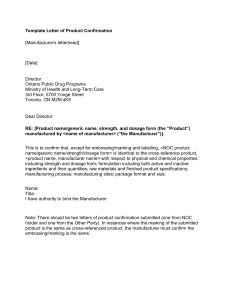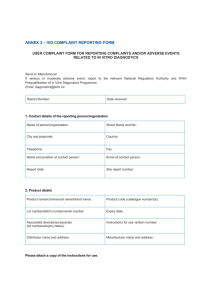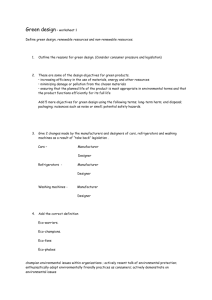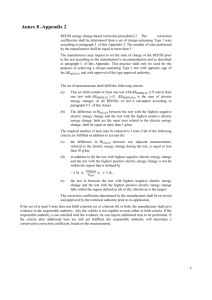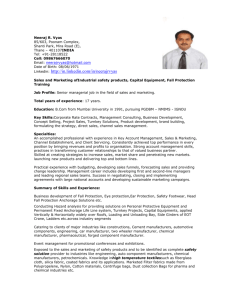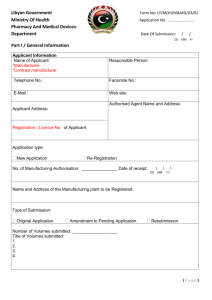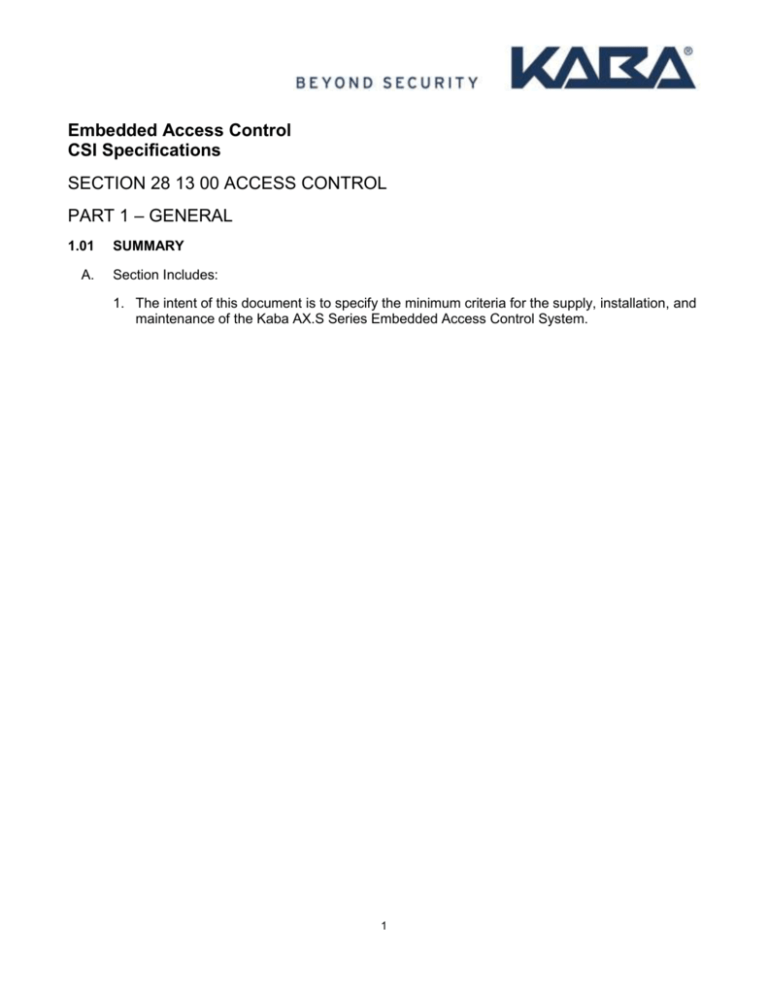
Embedded Access Control
CSI Specifications
SECTION 28 13 00 ACCESS CONTROL
PART 1 – GENERAL
1.01
A.
SUMMARY
Section Includes:
1. The intent of this document is to specify the minimum criteria for the supply, installation, and
maintenance of the Kaba AX.S Series Embedded Access Control System.
1
1.02
DEFINITIONS
TERM
AES
AM
API
DHCP
DIN Rail
DU
FTP
Installer
IP
ISO
LAN
Manufacturer
.NET
No Substitutes
Or Approved Equal
Or Equal
PACS
REST
RPC
RS-485
SCP
SMS
SNMP
SOAP
Software Update
Software Upgrade
SSH
SSL
System
TCP
Third Party
Manufacturer
UI
UPnP
WAN
XML
DESCRIPTION
Advanced Encryption Standard
Access Manager – a Kaba Embedded Access controller (AM300,
AM524)
Application Programming Interface
Dynamic Host Configuration Protocol
Metal rail of a standard type used to mount AM300 and AD500
Door Unit – a Kaba Embedded Access remote door unit (DU, AD500)
File Transfer Protocol
Local Kaba authorized installation company
Internet Protocol
International Standards Organization
Local Area Network
Kaba Access & Data Systems Americas
A Microsoft Operating System platform
The exact make and model number identified in this specification shall
be provided without exception.
A substitute for the specified item may be offered for approval by the
Customer. The proposed substitution must, in every technical sense,
provide the same or better capability, compatibility and functionality as
the specified item.
Any item may be substituted for the specified item provided that in
every technical sense, the substituted item provides the same or better
capability, compatibility and functionality.
Physical Access Control System
Representational State Transfer
Remote Procedure Call
Is a bi-directional serial communications standard protocol
Session Control Protocol
Short Message Service
Simple Network Management Protocol
Simple Object Access Protocol
Pertains to a bug fix release
Pertains to a release with added functionality
Secure Shell
Secure Socket Layer
Kaba’s AX.S Embedded Access Control System
Transmission Control Protocol
Supplier of PACS products that the Manufacturer resells as part of its
portfolio
User Interface
Universal Plug and Play
Wide Area Network
Extensive Markup Language
2
1.03
A.
REFERENCES
Reference Standards:
Systems specified in this section shall meet or exceed the requirements of the following:
1. Federal Communications Commission (FCC)
a. FCC Part 15 Class A Digital Device
2. CE Mark
1.04
A.
QUALITY ASSURANCE
Manufacturer’s Qualifications:
The PACS Manufacturer shall be a leading Manufacturer of access control solutions, with over
25 years of experience in the Security industry.
B.
Installer’s Certification:
The Installer shall be certified by Kaba.
1.05
A.
WARRANTY
Product:
1. Manufacturer’s hardware product(s): The Manufacturer shall warrant that the Manufacturer’s
hardware product(s) are free from defect in materials and/or workmanship for a period of two
(2) years from the date of purchase under normal use and service.
2. Third Party Manufacturer’s hardware product(s) sold by Manufacturer: The Manufacturer
shall warrant only to the extent provided by the original Manufacturer’s Warranty and
Purchaser must refer to the original Manufacturer’s Warranty in such case.
3. Manufacturer’s software product(s): The Manufacturer shall warrant that the Manufacturer’s
software product(s) media are free from defect in materials and/or workmanship for a period
of 90 days from the date of purchase under normal use and service.
1.06
A.
MAINTENANCE
Software:
The Manufacturer shall provide periodic Software Updates and Upgrades:
1. Software Updates will be available to the Customer through the Contractor.
2. Software Upgrades will be available as a separately price item.
1.07
A.
SUPPORT
On-site Support:
Customer support shall be provided by the Contractor.
3
B.
Certification:
Contractor shall provide evidence that it is an authorized dealer in good standing for the
Manufacturer of the System and that it meets the Manufacturer’s technical certification
requirements.
1.08
A.
SYSTEM DESCRIPTION
System Functions:
1. The System shall function as an embedded open-architecture PACS that: tracks People,
Credentials – including Cards, Fobs, Patches and fingerprint biometric templates, and
Areas; defines Schedules, Holidays, and Access Control Levels; monitors Events and
Alarms; manages a database of Personnel records, Event activity and System Configuration
information; and provides Report generation capability.
2. The System shall provide the Operator controlled access through a password-protected
user interface. Operators can communicate with the System via an Ethernet connection
either directly through the embedded Web server or via the central Web service application.
3. The System shall provide integrated fingerprint Biometric template support to allow for a
physical Credential less environment.
4. The System shall offer the ability to integrate Third Party Security Applications such as
Photo ID badging, Video, Visitor management and applications via REST and SOAP Web
Service APIs.
5. The Systems shall have the ability to send e-mail messages to selected Operators based on
selected Events and Alarm conditions.
B.
System Architecture:
1. The System solution shall be a scalable platform capable of supporting from one to
hundreds of remote access control points in one or more sites. The System service shall
allow access from any standard browser by authenticated users with proper credentials.
2. System configuration options include:
a. Kaba AM300, as a standalone system, includes an embedded software application for
system administration, user setup, and event viewing. Designed for small businesses or
branches, this solution offers multiple configurations and delivers access control for up to
eight access points (readers). When implemented with optional OC8/IC8 extension
module(s), a single reader allows users to selectively open specific access points (up to
24), eliminating Fingerprint Keys (Keypad) or Wiegand (Credential) readers at every
access point.
b. Kaba AM524, as a standalone system, includes an embedded access control application
for system administration, user setup and event viewing that is accessed via any
standard Web browser over a 10/100 Mbps Ethernet network. The AM524 supports from
one to 24 readers using supporting Door Units. The AM524 supports all standard access
control readers utilizing an RS-485 and/or Wiegand data connection through connected
Door Units. Supporting RS-485 communication between modules, the AM524 provides a
scalable solution by simply adding additional Door Units. Up to twelve Door Units
4
connect to an AM524 module, with each supporting two reader connections, for a total of
24 readers.
c. When configured in a Cluster, up to four AM524 Access Managers can communicate
with each other, providing for expansion and administration of up to 96 readers.
d. Kaba AM300 or AM524 with RS-485 connection and AR402: the Access Manager allows
fingerprint template distribution and controls access rights.
e. Kaba AM300 or AM524 with RS-485 connection, AR402 and Wiegand third party access
control system: the Access Manager unit only controls fingerprint distribution — the thirdparty system manages the access rights. In this setup, the biometric reader passes the
fingerprint up to the third-party system as a number, i.e. just like reading a card.
1.09
A.
SUBMITTALS
General:
Submittals shall be made in accordance with the Conditions of the Contract and Submittal
Procedures Section.
B.
Drawings and Schematics:
Shall depict the System in final proposed “as built” configuration. The following must be
provided:
1. Connection diagrams for interfacing equipment
2. List of connected equipment
3. Locations for all major equipment components to be installed under this specification
C.
Product Data:
The following shall be provided:
1. Technical data sheets
2. Quick reference setup guide
3. A complete set of instruction manuals
D.
Quality Assurance Submittals:
The following shall be submitted:
1. Manufacturer’s Instructions: The Installer shall deliver one set of System Operation and
Maintenance Manuals (if available) to the Owner for each Access Control System installed.
2. Notice of Completion: When the final acceptance has been satisfactorily completed, the
Owner shall issue a notice of completion to the Installer.
5
1.10
A.
DELIVERY, STORAGE, and HANDLING
General:
Delivery, storage, and handling of the Access Control System shall be in accordance with the
Manufacturer’s recommendations.
B.
Ordering:
The Manufacturer’s ordering instructions and lead-time requirements must be followed in order
to avoid installation delays.
C.
Delivery:
The Access Control System shall be delivered in the Manufacturer’s original, unopened,
undamaged container with identification labels intact.
D.
Storage and Protection:
The Access Control System shall be stored and protected from exposure to harmful weather
conditions and at the environmental conditions recommended by the Manufacturer.
6
PART 2 – PRODUCTS
2.01
A.
MANUFACTURER
Kaba Access & Data Systems Americas
1. 2941 Indiana Avenue, Winston-Salem, NC 27105
a. Tel: 1-800-849-8324
b. Fax: 800.346.9640
c. Website: http://www.kaba-adsamericas.com
2.02
PRODUCT SUBSTITUTIONS
A.
No substitutions permitted.
2.03
SYSTEM COMPONENTS
A.
Access Control Software
1. Embedded Access Control Software
a. Physical Access Control System (PACS)
b. System requires no user-installed software.
c. System requires no dedicated on-site PC hardware.
2. AXIAL – Central Enrollment and Database Management Software
a. Description: AXIAL is a .NET (client application) service for managing persons and
reporting of Kaba’s AX.S systems across multiple locations. AXIAL provides an
administrative interface to all managed system settings, including fingerprint templates.
Authorization and site assignment of persons are performed from the AXIAL application
and applied to the selected locations. Keeping the intelligence at each individually
managed location provides redundancy of critical configuration data. Additionally, all
managed systems forward their events to the AXIAL events database where system
reports may be generated across one or many managed locations.
b. Minimum System Requirements: Computer shall be equipped with the following capacities:
i.
Supported Operating Systems:
Microsoft® Windows® 7 32/64-bit
Microsoft Windows Vista (not tested)
Microsoft Windows XP Professional 32-bit
Microsoft Windows Server 2008
Microsoft Windows Server 2003 (not tested)
7
ii. Processor at 2 GHz or faster
iii. 2 GB RAM
iv. 120 GB hard disk
v. 1 USB port (for local credential enrollment)
vi. 19-inch, 1280 × 1024 true color monitor
vii. Standard keyboard
viii. Standard mouse
ix. Network Interface Card (NIC)
B.
Access Managers (AM)
1. AM300 (AD500, IC8, OC8)
2. AM524 (DU, AA200)
C.
Ancillary Components
1. Card Readers – Wiegand Interface
a. Kaba AR402 Fingerprint Biometric
b. HID Proximity
c. HID iCLASS®
2. Card Readers – RS-485 Interface
a. Kaba AR402 Fingerprint Biometric
b. HID Proximity
c. HID iCLASS
2.04
A.
AM300 – ACCESS MANAGER
Capacities
1. Readers:
a. On board: 0
b. External: up to 8 using AD500 Door Units
c. Interface: Wiegand or RS-485
2. Credentials:
a. Local: 1,000
8
3. Events:
a. Local: 10,000
4. Inputs:
a. On board: 0
b. External: up to 24 binary inputs using IC8 Input Extension Modules
5. Outputs:
a. On board: 0
b. External: up to 24 relay outputs using OC8 Output Extension Modules
6. Communications:
a. Ethernet: 10/100
7. Expansion Boards:
a. IC8 Input Extension Module
b. OC8 Output Extension Module
8. Power:
a. Input: 10 to 34 VDC
9. Power Consumption:
a. 3.6 W
10. Temperature and Humidity Range:
a. Operating Temperature: 32 °F to 122 °F, (0 °C to 50 °C)
b. Storage Temperature: -4 °F to 149 °F, (-20 °C to 65 °C)
c. Relative Humidity: 0 to 95%, non-condensing
11. Dimensions: without DIN rail mount
a. H x W x D: 4.9" x 3.9" x 1.8" (125mm x 99mm x 45mm)
12. Packaged Weight:
a. 0.53 lb. (240g)
13. Housing:
a. Plastic for mounting on DIN Rail (125mm)
9
14. Compliance:
a. FCC Part 15 Class A
b. CE Certified
B.
Expansion Modules
1. AD500 – Door Unit (for the AM300)
a. Capacities
1. Readers:
a. On board: 2
b. Interface: Wiegand or RS-485
2. Inputs:
a. On board: 6 binary
3. Outputs:
a. On board:
i.
Six binary outputs (open collector)
ii. Two relay outputs (max. 34v/3A)
4. Communications:
a. RS-485 to the AM300
5. Expansion Boards:
a. IC8 Input Extension Module
b. OC8 Output Extension Module
6. Power:
a. Input: 12 VDC +-15%
b. Load: 250 mA @ 12VDC
7. Power Consumption:
a. Typical consumption is 1.5 W up to 18 W
8. Temperature and Humidity Range:
a. Operating Temperature: 32 °F to 122 °F, (0 °C to 50 °C)
b. Storage Temperature: -4 °F to 149 °F, (-20 °C to 65 °C)
10
c. Relative Humidity: 0 to 95%, non-condensing
9. Dimensions: without DIN rail mount
a. H x W x D: 4.9" x 4.1" x 1.8" (125mm x 105mm x 45mm)
10. Packaged Weight:
a. 0.45 lb. (205g)
11. Housing:
a. Plastic housing for installation on DIN rail (125 mm)
12. Compliance:
a. FCC Part 15 Class A
b. CE Certified
2. IC8 – Input Expansion Module (for the AM300)
a. Capacities
1. Inputs:
a. On board: 8 binary inputs
b. LED Status Display
2. Power:
a. Input: provided by the AD500 Door Unit
3. Power Consumption:
a. Current consumption is max 200 mA @ 5VDC
4. Temperature and Humidity Range:
a. Operating Temperature: 32 °F to 122 °F, (0 °C to 50 °C)
b. Storage Temperature: -4 °F to 149 °F (-20 °C to 65 °C)
c. Relative Humidity: 0 to 95%, non-condensing
5. Dimensions: without DIN rail mount
a. H x W x D: 2.75" x 3.9" x 1.8" (70mm x 99mm x 45mm)
6. Packaged Weight:
a.
0.45 lb. (205g)
11
7. Housing:
a. Plastic housing for installation on DIN rail (125 mm)
8. Compliance:
a. FCC Part 15 Class A
b. CE Certified
3. OC8 – Output Expansion Module (for the AM300)
a. Capacities
1. Outputs:
a. On board: 8 relay outputs
b. LED Status Display
2. Power:
a. Input: provided by the AD500 Door Unit
3. Power Consumption:
a. Current consumption is max 200 mA @ 5VDC
4. Temperature and Humidity Range:
a. Operating Temperature: 32 °F to 122 °F, (0 °C to 50 °C)
b. Storage Temperature: -4 °F to 149 °F (-20 °C to 65 °C)
c. Relative Humidity: 0 to 95%, non-condensing
5. Dimensions: without DIN rail mount
a. H x W x D: 2.75" x 3.9" x 1.8" (70mm x 99mm x 45mm)
6. Packaged Weight:
a. 0.35 lb. (157g)
7. Housing:
a. Plastic housing for installation on DIN rail (125 mm)
8. Compliance:
a. FCC Part 15 Class A
b. CE Certified
12
2.05
A.
AM524 – ACCESS MANAGER
Capacities
1. Readers:
a. On board: 0
b. External: up to 24 per AM524 using DU Door Units
c. Clustered AM524s: up to 4 AM524s
d. Interface: Wiegand or RS-485
2. Credentials:
a. Local: 30,000
3. Events:
a. Local: 40,000
4. Inputs:
a. On board: 0
b. External: 6 binary inputs per DU
5. Outputs:
a. On board: 0
b. External: 7 outputs per DU (5 open collector, 2 Form C relays)
6. Communications:
a. Ethernet: 10/100
b. 3 x RS-485 Door Unit channels
7. Expansion Boards:
a. IC8 Input Extension Module
b. OC8 Output Extension Module
8. Power:
a. Input: 12 to 24 VDC
b. Load: 250 mA @ 12VDC
c. Power out to Readers: 2 x 12VDC
13
9. Power Consumption:
a. 3W
10. Temperature and Humidity range:
a. Operating Temperature: 32 °F to 104 °F, (0 °C to 40 °C)
b. Relative Humidity: 0 to 85%, non-condensing
11. Dimensions: with plastic enclosure
a. H x W x D: 4.7" x 4.7" x 1.6" (120mm x 120mm x 40mm)
12. Packaged Weight:
a. 0.80 lb. (363g)
13. Housing:
a. Plastic
14. Compliance:
a. FCC Part 15 Class A
b. CE Certified
B.
Expansion Modules
1. DU – Door Unit (for the AM524)
a. Capacities
1. Readers:
a. On board: 2
b. Interface: Wiegand or RS-485
2. Inputs:
a. On board: 6 binary
3. Outputs:
a. On board:
i.
Six binary outputs (open collector)
ii. Two relay outputs (max. 34v/3A)
4. Communications:
a. RS-485 to the AM524
14
5. Expansion Boards:
a. IC8 Input Extension Module
b. OC8 Output Extension Module
6. Power:
a. Input: 12 to 24 VDC
b. Load: 150 mA @ 12VDC
Maximum of 1.5A with connected readers
Typical 390 mA with connected readers
7. Power Consumption:
a. Typical consumption is 1.5 W up to 18 W
8. Temperature and Humidity Range:
a. Operating Temperature: 32 °F to 122 °F, (0 °C to 50 °C)
b. Relative Humidity: 0 to 85%, non-condensing
9. Dimensions: without DIN rail mount
a. H x W x D: 4.7" x 4.7" x 1.7" (120mm x 120mm x 43mm)
10. Packaged Weight:
a. 0.80 lb. (363g)
11. Housing:
a. Plastic
12. Compliance:
a. FCC Part 15 Class A
b. CE Certified
13. Alarm Interface Unit:
a. 1 dedicated
2. AA200 – Alarm Interface Unit (for the AM524) mounts on top of the DU
a. Capacities
1. Inputs:
a. On board: Four binary
15
2. Outputs:
a. On board:
i.
Three binary outputs (open collector)
ii. One relay output (0.5A, 30VDC)
3. Power:
a. Input: 12 to 24 VDC
b.
Load: 75 mA @ 12VDC
4. Power Consumption:
a. Typical consumption is 1.5 W up to 18 W
5. Temperature and Humidity Range:
a. Operating Temperature: 32 °F to 104 °F, (0 °C to 40 °C)
b. Relative Humidity: 0 to 85%, non-condensing
6. Dimensions:
a. H x W x D: 2.4" x 2.4" x 0.6" (60mm x 60mm x 15mm)
7. Packaged Weight:
a. 0.20 lb. (91g)
8. Housing:
a. Plastic
9. Compliance:
a. FCC Part 15 Class A
b. CE Certified
2.06
AR402 – FINGERPRINT BIOMETRIC KEYPAD READER
The AR402 Fingerprint Key is very scalable and flexible and implements easily into any new or existing
structure. When employed into a system, the AR402 supports fingerprint template distribution between
readers, eliminating the need to enroll users at each reader.
A.
Capacities
1. Reader Versions:
a. Standard: Biometric with Keypad
b. Optional: HID iCLASS with Biometric and Keypad
16
2. Credentials:
a. Standard: PIN and/or Biometric
b. Optional: iCLASS (13.56 MHz, ISO 15693)
3. Template Storage and Transfer:
a. Storage Options: 500 or 3,000
b. Optional: Store Template on iCLASS card
c. Template distribution between readers (where applicable)
4. Inputs:
a. Tamper Switch (contact 24V @ 0.1A)
5. Fingerprint Sensor:
a. Type: Optical
6. Communications:
a. Wiegand
b. RS-485
7. Embedded Software:
a. Embedded biometric application for enrollment in reader or on card
b. No computer or server required
8. Power:
a. Input: 12 to 24 VDC
b. Max: 420 mA @ 12VDC
c. Idle: 120 mA @ 12VDC
9. Keypad:
a. Sensor Touch – no moving parts; LED backlit
10. Temperature and Humidity range:
a. Operating Temperature: 14 °F to 122 °F, (-10 °C to 50 °C)
b. Relative Humidity: 10 to 95%, non-condensing
17
11. Dimensions: Single gang mount, includes mounting plate
a. H x W x D: 4.5" x 2.5" x 2.0" (115mm x 65mm x 51mm)
12. Packaged Weight:
a. 0.81 lb. (367g)
13. Housing:
a. IP65 listed enclosure (approved for indoor and outdoor use)
14. Compliance:
a. FCC Part 15 Class A
b. CE Certified
18
PART 3 – EXECUTION
3.01
A.
MANUFACTURER’S INSTRUCTIONS
Compliance:
1. Comply with Manufacturer’s written data, including product technical bulletins, product
catalog installation instructions, and product carton installation instructions.
3.02
A.
EXAMINATION
Site Verification of Conditions:
1. Verify that substrate conditions, which have either been previously installed under other
sections, or that existing site conditions, are acceptable for product installation in
accordance with Manufacturer’s instructions.
2. Verify that building doors, frames, walls, wire runs, related items, and conditions are ready to
receive work of this Section.
3.03
A.
PROTECTION
Other Trades:
1. Protect installed work of other trades.
3.04
A.
PREPARATION
Manufacturer Forms:
1. Obtain and complete project planning forms from Manufacturer of System; customize forms
to be project specific.
B.
Final Setup:
1. Review, adjust, and prepare final documents to establish System software setup.
C.
Record Setup Data:
1. Electrical Preparation:
a. Coordinate with trade where applicable.
2. Elevators:
a. Coordinate with trade where applicable.
3. Information Services:
a. Coordinate with trade where applicable.
4. Fire Alarm:
a. Coordinate with trade where applicable.
19
3.05
A.
INSTALLATION
Installation:
1. The installer shall show evidence of factory certification from the PACS Manufacturer.
2. The installer shall install all system components and appurtenances in accordance with the
Manufacturer’s specifications, referenced practices, guidelines, and applicable codes.
Furnish all necessary interconnections, services, and adjustments required for a complete
and operable system as specified. Control signal, communications, and data transmission
line grounding shall be installed as necessary to preclude ground loops, noise, and surges
from adversely affecting system operation.
B.
Wiring:
1. All wiring is to be installed in dedicated conduit throughout. Cable shall not be pulled into
conduits or placed in raceways, compartments, outlet boxes, junction boxes, or similar
fittings with other building wiring.
2. All low voltage wiring outside the control console, cabinets, boxes, and similar enclosures,
shall be plenum rated where required by code.
3. All wiring conductors connected to terminal strips shall be individually numbered and each
cable or wiring group being extended from a panel or cabinet to a building mounted device
shall be identified with the name and number of the particular device as identified and
shown on building drawings.
4. All exposed wiring inside and outside the control console, cabinets, boxes, and similar
enclosures, shall be dressed down neatly and secured with wiring cleats or wire ties.
C.
Containers:
1. All exposed metallic flexible conduit and armored cable shall be dressed down neatly and
secured with low profile, metal fasteners.
2. All cabinets, boxes, and similar enclosures containing security system components and/or
cabling, which may easily be accessible to employees or to the public, shall be provided with
a lock. Boxes above ceiling level in occupied areas of the building shall not be considered to
be accessible.
3. All junction boxes and small device enclosures below ceiling level, and easily accessible to
employees or the public, shall be covered with a suitable cover plate and secured with
tamper proof screws.
4. End-of-Line resistors shall be installed at the field device location and not at the controller
panel location.
D.
Drawings and Diagrams:
1. System devices identified on building drawings are intended to generally indicate areas
where such devices are to be located. Installers shall be responsible for determining final
location of these devices in accordance with Owner’s requirements.
20
2. Riser diagrams are schematic and do not show every conduit, wire box, fitting, or other
accessories. Provide such materials as necessary for a complete and functioning
installation. Install in accordance with referenced codes and these specifications. Use
weatherproof equipment or covers where installed in areas exposed to weather.
3.06
A.
POST-INSTALLATION
Software Updates:
Software updates to the AXIAL application are to be delivered by the Contractor.
B.
Firmware Updates:
Firmware updates to AMs are to be delivered by the Contractor.
3.07
A.
FIELD QUALITY CONTROL
Written Reports:
1. Installer must note any variants at the site and notify Owner’s representative within three
business days of anything that might affect the delivery date of the system or any trades
associated with the functioning of the system.
B.
Manufacturer’s Field Services:
1. When applicable, Installer is to coordinate a specific number of visits with the Manufacturer’s
engineering support team for the system design, insulation, commissioning, final testing, or
training.
3.08
A.
TESTING & VERIFICATION
Performance Testing:
Perform tests recommended and required by Manufacturer to verify required performance of
Kaba Systems products.
B.
System:
The Installer is required to place entire system into full and proper operation as designed and
specified.
C.
Hardware:
Verify that all hardware components are properly installed, connected, communicating, and
operating correctly.
D.
Software:
Verify that all system software is installed, configured, and complies with specified functional
requirements.
21
3.09
A.
COMPLETION & CLEANUP
Cleanup:
Upon completion and verification of performance of installation, remove surplus materials,
excess materials, rubbish, tools, and equipment.
B.
Final Acceptance Testing:
The Installer shall perform final acceptance testing in the presence of Owner’s representative,
executing a point by point inspection against a documented test plan that demonstrates
compliance with system requirements as designed and specified:
1. Submit documented test plan to Owner at least (14) days in advance of acceptance test,
inspection, and check-off.
2. Conduct final acceptance tests in presence of Owner’s representative, verifying that each
device point and sequence is operating correctly and properly reporting back to control
panel and control center.
3. Acceptance by Owner is contingent on successful completion of check-off; if check-off is not
completed due to additional work required, re-schedule and perform complete check-off until
complete in one pass, unless portions of system can be verified as not adversely affected by
additional work.
4. The system shall not be considered accepted until all acceptance test items have been
successfully checked-off. Beneficial use of part or all of the system shall not be considered
as acceptance.
C.
Training:
The Installer shall provide system operations, administration, and maintenance training by
factory trained personnel qualified to instruct in the following areas:
1. Owner will designate personnel to be trained.
2. Provide printed training materials for each trainee, including product manuals, course
outline, workbook or student guides, and written examinations for certification.
3. Provide hands-on training with operational equipment.
SECTION END
While reasonable efforts were made to ensure the accuracy of this document at the time of printing, Kaba assumes no liability for any errors or
omissions. This information is subject to be revised without notice, and changes may be incorporated in future releases. For the most up-todate information, visit www.kaba-adsamericas.com. Copyright © 2014 Kaba ADS Americas. All rights reserved.
KAA1327 0114
22




